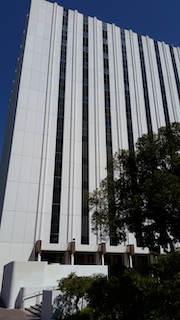Eleven Common Criminal Law Motions to Consider Early
The following eleven motions are some of the more common motions that might apply in any criminal case. Rarely are more than one or two of such motions applicable, but some cases may be subject to more than one. We present this list to stimulate thought on various defenses that may apply and to help defendant and his or her attorney strategize the defense.
 Compton Courthouse
Compton Courthouse
1. Motion for a Pre-Trial Line Up. This motion is filed when mistaken identity of defendant as the suspect is the issue. It may be that the witness or victim was intoxicated, the lighting conditions were poor or defendant’s appearance contradicts the description of the suspect stated on the 911 call, if any, or the police report. Evans v. Superior Court (1974) 11 Cal. 3d 617.
2. Motion to Dismiss a General Charge. This motion is used to ask a judge to dismiss a charge or charges, where the prosecution files under a general charging statute when a more specific section exists and more properly applies. People v. Swann (1963) 213 Cal. App. 2d 447, People v. Gilbert (1969) Cal. 3d 475.
3. Trombetta Motion. This is a motion to dismiss for the prosecutor’s bad faith destruction of exonerating evidence. This is difficult to show; even if one gives notice to the prosecution to preserve such evidence. This is further difficult to demonstrate; even if one gives notice to the prosecution to preserve such evidence. California v. Trombetta (1984) 467 U.S. 479; see also Arizona v. Youngblood (1988) 488 U.S. 51.
4. Mejia Motion. This is a rare motion, but it can be determinative as to the outcome of the case. It is a motion to dismiss or suppress certain evidence when a known defense witness is deported. People v. Mejia (1976) 57 Cal. App. 3d 574. This motion may become less rare now when and if Donald Trump’s new immigration policies become law.
5. Serna Motion. This is a motion to dismiss the complaint based on a violation of defendant’s California speedy trial rights when the period of pre-arraignment delay (after the case is filed) exceeds the statute of limitations. Serna v. Superior Court (1985) 40 Cal. 3d 239.
6. Jailhouse Informant Motion. A motion to exclude statements made by a defendant to a jailhouse informant in violation of defendant’s right to counsel. United States v. Henry (1980) 447 U.S. 264; Massiah v. United States (1964) 377 U.S. 201.
7. Franks Motion. This is often used in drug, child pornography, theft and white collar crimes. It is a motion to suppress evidence seized under a search warrant based on an affidavit being insufficient after the misstatements in it are removed. Franks v. Delaware (1978) 438 U.S. 154.
8. Motion to Compel Confidential Informant Information. This motion is common is large drug cases, white collar crimes, child pornography cases, and other more premeditated, complex cases. Theodor v. Superior Court (1972) 8 Cal. 3d 77.
9. Speedy Arraignment Motion. This is a motion to suppress evidence, usually a confession, based on a violation of defendant’s right to a speedy arraignment. Mallory v. United States (1957) 354 U.S. 448. This is more commonly seen in federal court.
10. Brady Motion. This motion asks the judge to order the prosecution to disclose exonerating information helpful to defendant. Brady v. Maryland (1963); see also California Penal Code § 1054.1 and Izazaga v. Superior Court (1991) 54 Cal. 3d 356. This type of motion hits hard at suggesting the prosecutor is hiding evidence or at least sand-bagging defendant to gain an advantage or otherwise extract a conviction of an innocent person.
11. Pitchess Motion. This is a motion for disclosure of a police officer’s personnel file for documents from the prior five years suggesting the instant case is proof of an officer’s continued history of racial profiling, excessive force, concerning confessions, planting evidence or other similar “dirty cop” evidence. Pitchess v. Superior Court (1974) 11 Cal. 3d 531, codified at California Evidence Code §§ 1043-1047.
For more information about the issues covered in the motions described, please click on the following articles:
Contact us.
 Greg Hill & Associates Home
Greg Hill & Associates Home




















